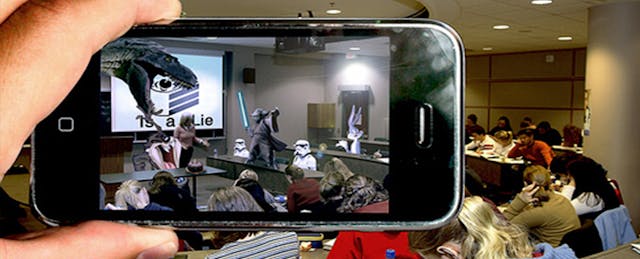Augmented Reality is changing education. What started out as something that was simply “cool” has become a way to engage learners like never before.
In fact, while I was first introduced to Augmented Reality through the Aurasma App, I never imagined that while walking through a trendy neighborhood in Washington D.C. this past summer, I would come across the first public interactive augmented reality mural dedicated to the life of the actor Paul Robeson. Designed by artist Corey L. Stowers, this mural allows viewers to scan and thus trigger images of his artwork with their mobile devices, accessing historical videos and original content that depict the life of the great athlete, performer, and civil rights activist.
It was at this moment that I realized that Augmented Reality was a way to bring a new dimension to learning. By unlocking the everyday world, one can dig deeper and engage learners in a new and interesting way.
What is “Augmented Reality”?
Augmented Reality (AR) content can be accessed by scanning or viewing a trigger image with a mobile device that creates a subsequent action. This action can be a video, another image, 3D Animations, Games, QR code, or whatever you want it to be. For example, take a look at this GIF below to see real AR in action.
How can I start using AR in my classroom?
Using the Aurasma App and Aurasma Studio, you can create your own “Auras” (or AR experiences), and use them to engage students in creative ways. For example, jazz up your school’s art show, or make math come alive through videos of students solving math problems--perhaps students can trigger an Aura by pointing their smartphone at a particular equation. You could even attach a trigger image to a Google Form to request time with the school counselor, or make a class picture image on your teacher website trigger a virtual tour of a classroom.
And why exactly should I start doing this? It sounds like a lot of work.
Augmented reality apps connected to content can create mind-blowing learning experiences and endless learning possibilities. These type of learning experiences really speak to the needs of visual learners.
The beauty of Augmented Reality is that the learning experiences can be as easy or as complex as you want. You can create your own, or download the numerous already-made apps connected to various content. But what’s even more enticing is that students can easily create these experiences on their own in a matter of minutes.
What are the best AR apps and resources out there?
The options for using AR are endless, and so here a few awesome Augmented Reality apps and resources being used in classrooms to provide engaging content and interactions for students:
- Popar Toys: This catalog of AR resources changes the way children read books, look at posters, or complete puzzles. (Basically, everything is an animated picture!) Enjoy their interactive books on Planets, Bugs, Dinosaurs, Safari, and Sea Life, or perhaps the interactive charts on Human Anatomy, Periodic Tables, World Maps, The Solar System and US Presidents.
- Daqri: One of the leading augmented reality developers, Daqri is the creator of Daqri Studio--a truly creative tool for designing your own Augmented Reality projects. Science teachers, check out Anatomy 4D (which allows you to view 3-D images of the human body, and heart) and Elements 4D (which enhances a chemistry classroom by bringing the periodic table to life).
- Quiver (formerly Colar) App: Quiver has different coloring pages from every subject area. When partnered with the app, the coloring pages come to life and have animated actions. For instance, students can create their own flag, and tie it to science and weather by controlling the wind. Or, check out a world map that shows day and night views of the world when activated with the app.
- Chromville: Chromville’s science-based coloring pages ignite creativity in children through art, technology, and the eight multiple intelligences. The Chromville Visual App uses its characters to promote storytelling and features a classroom component that has coloring pages explaining the likes of the human body and parts of plant.
- Fetch Lunch Rush: This fun PBS kids game app uses printable cards as augmented reality game pieces. In the game, kids help Ruff the Dog feed sushi to a movie crew by solving the math problems. Each game piece is a trigger image that comes to life when scanned.
- STAR Augmented Reality Worksheets: With these interactive materials, the worksheet comes alive and transposes 3-dimensional models and video resources to reinforce content.
- AugThat: Developed by a former teacher, AugThat creates augmented reality content for classrooms, specifically targeting students that fall through the cracks and aren’t engaged. They create animated lessons in a variety of formats, including 360-degree virtual environments and 3-dimensional experiences.
- Two Guys and Some iPads: These sought-after keynote speakers and Augmented Reality gurus share various ways to incorporate Augmented Reality into the classroom and give practical examples of simple ways that teachers around the world are using AR.
Augmented Reality is an example of a technology that can make classroom learning more transformational and engaging. What in the past had seemed like fantasy is now a part of our reality. There are practical examples for Augmented Reality being used in classrooms around the world, as the ability to overlay digital content and information onto the real world--using triggers like images and locations--opens up a whole new world of learning opportunities.
Do you want to allow students to interact with 3D models? Bring learning to life? Break down the walls of the classroom? Experiment with an AR app--and see the magic happen.
What other ideas do you have about incorporating Augmented Reality in your classroom?


